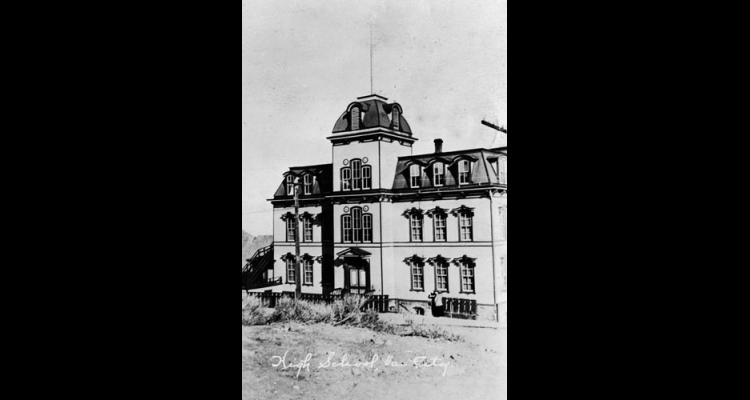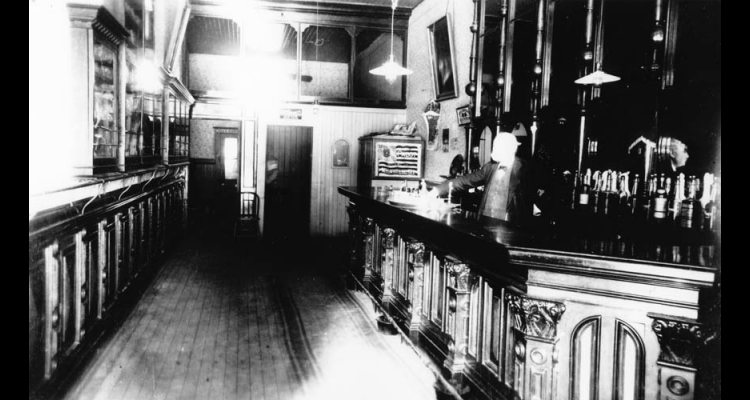Virginia City and Gold Hill
Virginia City was known as the Queen of the Comstock, the internationally famous mining district. Founded in 1859, the settlement was the focus of a gold rush and within a year, it became the region's largest community, a status it maintained in Nevada into the 1890s. Virginia City was incorporated under the Utah Territory in 1861.
Early in their history, Virginia City and its southern neighbor, Gold Hill, grew until they met at a place known as the Divide. Smaller Gold Hill was working class compared with Virginia City's elegance. Together, they were a dynamic center of industry, technological innovation, social diversity, and cultural sophistication.
Residents named Virginia City for early miner James "Old Virginny" Finney. Gold Hill describes the mound of earth where miners found a rich deposit of gold. The two towns overshadowed nearby Silver City, Dayton, American City, Lousetown, and Sutro City.
Mount Davidson—originally Sun Mountain—dominated the Comstock. Virginia City clung to its slope with an elevation of more than 6,000 feet. Runaway wagons were a daily occurrence on its steep streets. Virginia City's commercial thoroughfare led to a southern descent to Gold Hill with hairpin turns known as Greiner's Bend. This community built on a slant earned the nickname "Slippery Gulch" for its often muddy, precipitous main street.
Virginia City's reputation grew with the tons of rich ore produced over two decades of affluence. Wealth attracted people from throughout the world. Initially, North Americans dominated the Comstock, but soon every continent sent representatives. By 1880, a third of Virginia City was Irish. Cornish immigrants preferred Gold Hill. Virginia City's Chinatown numbered over 1,500 at its height in the early 1870s and was one of the nineteenth century's largest Asian communities in North America. Among the many groups, African Americans, Native Americans, and speakers of Spanish also had a presence.
Most Virginia City and Gold Hill residents prospered as wage earning miners, business owners, or by filling diverse economic niches during the flush time from 1859 to 1880. The central focus, of course, was always the mines, whose steam engines and stamp mills roared with a constant din. Because water always threatened to flood depths that reached 3,200 feet, pumps operated constantly, requiring three, eight-hour shifts of miners. Workers continually filled the streets, either leaving from or going to work.
From the Ophir and Mexican at the north end of Virginia City to the Yellow Jacket and the Crown Point in Gold Hill, Comstock mines won fame nationally for their wealth, attracting investors to the stock market. Miners quickly capitalized on the affluence, becoming the first in the West to unionize. With governmental support, mine owners resisted the 1863 union demands. Workers subsequently made certain that only pro-labor candidates won elections. Their union strengthened, Comstock miners won a four-dollar minimum for an eight-hour shift, making them the highest paid industrial workers in the nation.
Although Comstock mining companies prided themselves on safety, these were dangerous places, and it was a rare week without a funeral procession for someone killed underground. The worst incident occurred on April 7, 1869 when fire broke out at the Yellow Jacket Mine's 800-foot level. Perhaps more then forty miners died. The exact number remained undetermined because many were never recovered.
On the surface, Virginia City and Gold Hill were vibrant places filled with opportunities to spend newly-acquired wealth. Residents could attend theaters ranging from comedy clubs to opera houses, or they could select from diverse saloons offering food, target practicing, billiards, gambling, luxurious settings, or ethnic camaraderie. Intrepid souls ventured into Chinatown for exotic medicines, foods, or for its opium dens.
At its height, a thriving red light district included nearly two hundred prostitutes, but the vast majority of Comstock women were respectable and often married with children. By 1880, about one third of Virginia City and Gold Hill were under the age of eighteen. The school district strived to offer the best education possible. The monumental Fourth Ward School opened in 1877, offering space for one thousand students. For six decades, the institution was a source of pride for its commitment to excellence.
Notables who won their start in Virginia City included Samuel Clemens who first reported as Mark Twain for the Territorial Enterprise. George Hearst, father of William Randolph Hearst, founded his economic empire with Comstock ore. The Bank of California with its leaders William Ralston and William Sharon dominated Nevada's economy in the 1860s and early 1870s. John Mackay and James Fair became nationally famous as great silver barons. William Stewart, a lawyer, argued the famed Single-Ledge Case that settled ownership claims on the Comstock. As a U.S. Senator, he played a pivotal role in the development of the 1866 National Mining Law including its important 1872 amendment. Today, this legislation still governs mining in the United States.
Other residents of note included Philipp Deidesheimer, inventor of the famed square-set timber method. Richard Jose, an orphaned Cornish immigrant who sang for handouts on the streets of Virginia City, earned international renown as a performer. Father Patrick Manogue, builder of the magnificent St. Mary in the Mountains Catholic Church in 1876, became the Sacramento bishop of an expansive western diocese. Albert Michelson left Virginia City for Annapolis and eventually won the Nobel Prize for his optics and his measurements of the speed of light. Newspaper publisher Joseph Goodman, who gave Samuel Clemens his start as a writer, took his own place in history by cracking the code of the Mayan calendar. Gold Hill gave Nevada its first native-born governor with Emmet Boyle.
Together, all the Comstock towns experienced periods of prosperity and depression. Economic collapse in the 1880s was particularly hard on Gold Hill, but a dwindling Virginia City continued to exist, in part due to a metamorphosis that occurred after the premiere of the television show Bonanza in 1959. In 1961, the National Park Service listed the Comstock as the Virginia City Historic Landmark District, one of the nation's largest. Over one million tourists visit Virginia City annually.
Article Locations
Related Articles
None at this time.




